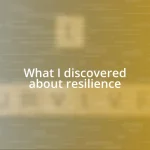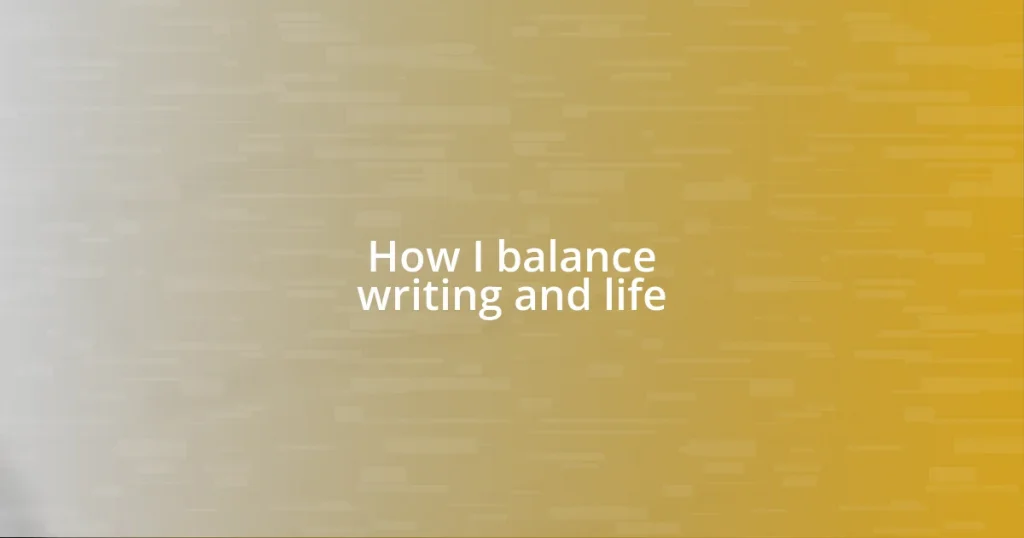Key takeaways:
- Understanding your target market involves building relationships and discovering customer motivations beyond demographics, which can transform product offerings into essential solutions.
- Creating a compelling offer requires highlighting benefits, establishing a clear value proposition, and fostering connections through personal touches like testimonials and bundled products.
- Successful sales close by addressing customer concerns, creating urgency with limited-time offers, and following up with gratitude to nurture long-term relationships.

Understanding your target market
Understanding your target market is like discovering a hidden treasure map; it guides you to where your ideal customers are. When I first began my journey in sales, I took the time to immerse myself in the world of my potential buyers. I remember chatting with a few of them over coffee, listening to their needs and concerns. It was eye-opening to realize that what I thought they wanted often differed from reality.
Have you ever considered how crucial it is to know not just who your customers are, but what drives them? In my early days, I created a customer persona based purely on demographics. Later, I learned that their motivations and challenges—the emotional stuff—really shaped whether they’d make a purchase. One memorable moment was when a customer revealed that it wasn’t just about the product; it was about how it fit into their lifestyle and values. That insight made me rethink my entire approach.
Identifying your target market goes beyond statistics—it’s about building relationships. I found that social media is a fantastic tool for this. I often engage with my audience through polls and questions, which not only gives me insight but makes them feel valued and heard. In those conversations, I glean valuable insights that help fine-tune my offerings, transforming my products from mere goods into solutions they truly need. Wouldn’t you agree that understanding those deeper connections is what really drives successful sales?

Building a product or service
Building a product or service is an exhilarating journey that starts with an idea but requires you to dig a little deeper. I still recall the moment I nailed down the core concept of my first product. Sitting at my kitchen table with a notepad, I jotted down what I believed would solve a significant problem for my potential customers. The excitement was palpable, but I quickly learned that it wasn’t just about the idea; it was about rigorously validating it. I conducted surveys and gathered feedback, which pivotal insights highlighted the need for practical features that I hadn’t initially considered.
As I progressed, I discovered the importance of balancing functionality with design. For instance, one of my early prototypes was functional but, honestly, looked a bit clunky. After some candid feedback from friends—and a few not-so-great reviews—I realized that aesthetic appeal could influence purchasing decisions as much as practical benefits. It was fascinating to witness how users reacted more positively to an updated version with a sleeker design, even though the functionality remained similar.
Finding the sweet spot between what my audience wanted and what I could realistically deliver took time and experimentation. I vividly recall a round of testing where I hosted a small focus group. Seeing participants interact with my product firsthand, their genuine reactions, and suggestions shaped my final version significantly. It taught me that building a product isn’t just about your vision; it’s an ever-evolving dialogue with your target audience that leads to richer, more desirable offerings.
| Aspect | My Experience |
|---|---|
| Initial Idea | Creative brainstorming at home, felt overwhelming yet exciting. |
| Validation | Surveys helped refine the product based on real feedback. |
| Functionality vs. Design | Realized design impact after friends pointed out clunkiness. |
| Focus Groups | Valuable insights from users enhanced the final product. |

Creating a compelling offer
Creating a compelling offer revolves around understanding not just what you’re selling, but how it resonates with your audience. I remember crafting my first offer and feeling a mix of excitement and fear. I asked myself, “What are they going to find irresistible?” To find the answer, I listened closely to what potential customers valued most. For me, that clarity came from countless discussions. I discovered that highlighting the benefits rather than just the features really struck a chord.
Here are some essential elements I found beneficial in crafting my offer:
- Clear Value Proposition: Articulate how your product can improve your customer’s life.
- Limited-Time Offers: Create a sense of urgency that compels action.
- Real-life Testimonials: Showcase relatable stories from people who have benefited.
- Unique Selling Points: Identify what sets you apart from competitors and emphasize it.
- Bundling Products: Offer complementary items together at a discounted rate to add more value.
I’ll never forget the thrill of launching my initial promotion. Much to my surprise, a last-minute idea to include a personal note with each purchase made the offer feel special. Customers responded enthusiastically, sharing how those little touches made them feel connected to me and my brand. It was a meaningful lesson: a compelling offer isn’t just about the transaction; it’s about creating a connection that encourages trust and loyalty.

Setting up your sales platform
Setting up your sales platform is a crucial step that deserves careful consideration. When I was ready to make my first sale, I vividly remember the overwhelming choices I faced. Should I use an established marketplace like Etsy or build my own website? I quickly realized that choosing the right platform can significantly impact how customers perceive my product and, ultimately, how they buy it.
I settled on a user-friendly website builder that offered beautiful templates and integrated payment solutions. The idea of showcasing my brand in a way that felt uniquely mine thrilled me. As I designed the layout, I found myself immersed in every detail—choosing colors, fonts, and images that truly captured the essence of my product. I often asked myself, “What will make visitors feel welcome and eager to explore?” Striking that balance between aesthetics and functionality became my mantra.
Another essential aspect was ensuring mobile compatibility. At one point, I remember checking how my site looked on my phone while sipping coffee at a café. I was shocked to see that it didn’t quite fit. This prompted me to revisit my design, ensuring potential customers could navigate seamlessly on any device. It’s the little details, like mobile optimization and intuitive navigation, that can significantly enhance the buying experience and build trust with your audience.

Implementing effective marketing strategies
When I dove into marketing strategies, I realized that connecting authentically with my audience was crucial. One surprising method for me was using social media to showcase not just my products, but my personality. I decided to share behind-the-scenes glimpses of my creative process. Trust me, it made a difference! I found that when I opened up about my journey, customers felt more inclined to engage. I often thought, “Wouldn’t I want to know the person behind the product?” This approach transformed my audience into a community.
Creating content that resonates is another tactic that significantly boosted my visibility. I remember writing a blog post about the inspiration behind my products. Not only did it help my audience understand my vision, but it also sparked conversations. The comments section became a space for shared stories and experiences, which strengthened the connection I had with my customers. I often pondered this: “What stories are worth sharing?” Those narratives didn’t just promote sales; they built relationships.
Moreover, I unwrapped the power of targeted advertising. When I first dipped my toes into Facebook ads, I felt a rush of excitement mixed with doubt. Would they really work? By carefully optimizing my audience settings based on demographics and interests, I was able to reach individuals who were genuinely interested in my niche. I distinctly recall a moment when a well-timed ad led to a sale right after launching it; it felt like magic. That experience taught me that effective marketing engages both the heart and mind, leading to conversions that feel like a natural outcome rather than a hard sell.

Interacting with potential customers
Interacting with potential customers has always felt like an art form to me. I can still recall my initial approach—I started by simply reaching out through direct messages on social media. With every conversation, I was genuinely excited to learn about their needs and preferences. It was intriguing to see how a small interaction could lead to meaningful feedback and even suggestions. I would often ask, “What excites you about my product?” The answers I received not only guided my offerings but also made me feel more connected to the people I aimed to serve.
One memorable experience involved a potential customer who had questions about a specific feature of my product. Instead of sending a quick response, I decided to set up a Zoom call. That conversation transformed the dynamic; it allowed me to explain my product in depth and really listen to her concerns. By the end of our talk, not only did she place an order, but I gained a loyal customer who regularly shares my brand with her friends. It felt rewarding to forge a relationship that extended beyond a simple transaction.
I’ve learned that just being present and approachable can pave the way for a thriving relationship with my audience. I recall a time when I hosted a live Q&A session online. The nerves were real—what if no one showed up? But surprisingly, a small group came with valuable questions, turning what I initially feared into an engaging discussion. Those moments taught me a crucial lesson: The more I engage, the more I build trust, and trust is the foundation of any sale. How can something so simple have such a profound effect?

Closing the sale successfully
Closing a sale successfully requires a blend of personal connection and clarity. I vividly remember my first sale experience; it was an exhilarating mix of excitement and nervous energy as I prepared to finalize that transaction. I discovered that laying out a clear value proposition made a world of difference. When my potential customer expressed hesitation, I simply asked her, “What concerns do you have?” Listening carefully to her needs not only allowed me to address her specific worries, but it also built her confidence in my product.
Once the doubts were alleviated, I shifted my focus to creating a sense of urgency. I remember introducing a limited-time offer during our conversation. That little nudge—”This promotion ends tonight!”—sparked a reaction I didn’t expect! Suddenly, the sale went from a “maybe” to a “definitely.” By mixing authenticity with strategic deadlines, I realized that I was not just pushing a product; I was genuinely helping someone make a decision that would enhance her life.
Most importantly, I learned that follow-up is equally vital to closing the sale. After our successful transaction, I sent a personalized thank-you message, acknowledging her trust in my brand. Reflecting on that moment, I can’t help but wonder: How often do we overlook the power of gratitude? Building that rapport didn’t just lead to a sale; it blossomed into an ongoing relationship where she became a repeat customer and advocated for my brand. In my experience, closing a sale is truly about creating lasting connections that extend well beyond the first purchase.















